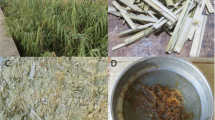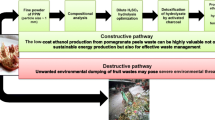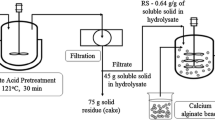Abstract
Recently, research on the production of ethanol from waste has been accelerating for both ecological and economical reasons, primarily for its use as an alternative to petroleum based fuels. In this study, response surface methodology based 23 -full factorial central composite design was employed to optimize the parameters of ethanol production from Korean food waste leachate. The reducing sugar concentration of the food waste leachate determined by the dinitrosalicylic acid method was 75 g/L. A second order polynomial model was developed to evaluate the quantitative effects of temperature, pH and reducing sugar concentration in order to find an optimum condition for the ethanol production from food waste leachate. From the experimental result, maximum ethanol concentration of 24.17 g/L was obtained at the optimum condition of temperature (38 °C), pH (5.45) and reducing sugar concentration (75 g/L). The experimental value (24.17 g/L) agreed very well with the predicted one (23.66 g/L), indicating the suitability of the model employed and the success of response surface methodology in optimizing the conditions of ethanol production from food waste leachate. Canonical analysis indicated that the stationary point was a saddle point for the ethanol yield. Despite being a waste, an ethanol yield of 0.32 g ethanol/g reducing sugar demonstrated the potential of food waste leachate as a promising biomass resource for the production of ethanol.
Similar content being viewed by others
References
APHA, (1998). Standard Methods for Examination of Water and Wastewater, 20th Ed., American Public Health Association, Washington, D.C.
Castillo, F. J.; Izaguirre, M. E.; Michelena, V.; Moreno, B., (1982). Optimization of fermentation conditions for ethanol production from whey. Biotech. Lett., 4 (9), 567–572 (6 pages).
Cazetta, M. L.; Celligoi, M. A. P. C; Buzato, J. B.; Scarmino, I. S., (2007). Fermentation of molasses by Zymomonas mobilis: Effects of temperature and sugar concentration on ethanol production. Bioresour. Tech., 98 (15), 2824–2828 (5 pages).
Chauhan, B.; Gupta, R., (2004). Application of statistical experimental design for optimization of alkaline protease production from Bacillus sp. RGR-14. Proc. Biochem., 39 (12), 2115–2122 (8 pages).
Douglas, C. M., (2001). Design and analysis of experiments. 5th. Ed. John Wiley and Sons, Arizona, USA.
Ebrahimi, F.; Khanahmadi, M.; Roodpeyma, S.; Taherzadeh, M. J., (2007). Ethanol production from bread residues. Biomass Bioenerg., 32 (4), 333–337 (5 pages).
Gaspar, M.; Kaiman, G; Reczey, K., (2007). Corn fiber as a raw material for hemicellulose and ethanol production. Proc. Biochem., 42 (7), 1135–1139 (5 pages).
Iranmahboob, J.; Nadim, F.; Monemi, S., (2001). Optimizing acid-hydrolysis: a critical step for production of ethanol from mixed wood chips. Biomass Bioenerg., 22 (5), 401–404 (5 pages).
Jo, M. S.; Rene, E. R.; Kim, S. H.; Park, H. S., (2008). An analysis of synergistic and antagonistic behavior during BTEX removal in batch system using response surface methodology. J. Hazard. Mater., 152 (3), 1276–1284 (9 pages).
Kádár, Z.; Szengyel, Z.; Reczey, K., (2004). Simultaneous saccharification and fermentation (SSF) of industrial wastes for the production of ethanol. Ind. Crop Prod., 20 (1), 103–110 (8 pages).
Kim, J. K.; Han, G. H.; Oh, B. R.; Chun, Y. N.; Eom, C. Y.; Kim, S. W., (2008). Volumetric scale-up of a three stage fermentation system for food waste treatment. Bioresour. Tech., 99 (10), 4394–4399 (6 pages).
King, F. G; Hossain, M. A., (1982). The effect of temperature, pH, and initial glucose concentration on the kinetics of ethanol production by Zymomonas mobilis in batch fermentation. Biotech. Lett. 4 (8), 531–536 (6 pages).
Le Man, H.; Kim, J. W.; Park, H. S., (2008). Optimization of ethanol production from Korean food waste leachate using response surface methodology. In Korea Society of Waste Management conference, Sunchon University, Sunchon, Republic of Korea 8–10 May.
Lee, D. H.; Behera, S. K.; Won, J. W.; Park, H. S., (2009). Methane production potential of leachate generated from Korean food waste recycling facilities: A lab-scale study. Waste Manage., 29 (2), 876–882 (7 pages).
McMeckin, T. A.; Olley, J.; Ratkwsky, D. A; Ross, T., (2002). Predictive microbiology: towards the interface and beyond. Int. J. Food Microbiol., 73 (2–3), 395–407 (12 pages).
McMillan, J. D. (1997). Bioethanol production: Status and prospects. Renew Energ., 10 (2), 295–302 (8 pages).
Miller, G. L., (1959). Use of DNS reagent for determination of reducing sugars. Anal. Chem., 31, 426–428 (3 pages).
Muralidhar, R.; Gummadi, S. N.; Dasu, V. V.; Panda, T., (2003). Statistical analysis on some critical parameters affecting the formation of protoplasts from the mycelium of Penicillium griseofulvum. Biochem. Eng. J., 16 (3), 229–235 (7 pages).
Nahvi, I.; Emtiaxi, G.; Alkabi, L., (2002). Isolation of a flocculating Saccharomyces cerevisiae and investigation of its performance in the fermentation of beet molasses to ethanol. Biomass Bioenerg., 23 (6), 481–486 (6 pages).
Nigam, J. N., (2000). Continuous ethanol production from pineapple cannery waste using immobilized yeast cells. J. Biotech., 80 (2), 189–193 (5 pages).
Ozmihci, S.; Kargi, F., (2007). Effects of feed sugar concentration on continuous ethanol fermentation of cheese whey powder solution (CWP). Enzyme Microb. Tech., 41 (6–7), 876–880 (5 pages).
Pena, A.; Cinco, G.; Gomez-Puyou, A.; Tuena, M., (1972). Effect of the pH of the incubation medium on glycolysis and respiration in Saccharomyces cerevisiae. Arch. Biochem. Biophys., 153 (2), 413–425 (13 pages).
Phisalaphong, M.; Srirattana, N.; Tanthapanichakoon, W., (2005). Mathematical modeling to investigate temperature effect on kinetic parameters of ethanol fermentation. Biochem. Eng. J., 28 (1), 36–43 (8 pages).
Ratnam, B. V. V.; Rao, M. N.; Rao, M. D.; Rao, S. S.; Ayyanna, C., (2003). Optimization of fermentation conditions for the production of ethanol from sago starch using response methodology. World J. Microb. Biot, 19 (5), 523–526 (4 pages).
Ravikumar, K.; Pakshirajan, K.; Swaminathan, T.; Balu, K., (2005). Optimization of batch process parameters using response surface methodology for dye removal by a novel adsorbent. Chem. Eng. J., 105 (3), 131–138 (8 pages).
Rene, E. R.; Jo, M. S.; Kim, S. H.; Park, H. S., (2007). Statistical analysis of main and interaction effects during the removal of BTEX mixtures in batch conditions, using wastewater treatment plant sludge microbes. Int. J. Environ. Sci. Tech., 4 (2), 177–182 (6 pages).
Rivera, E. C.; Costa, A. C.; Atala, D. I. P.; Maugeri, F.; Maciel, M. R. W.; Filho, R. M., (2006). Evaluation of optimization techniques for parameter estimation: Application to ethanol fermentation considering the effect of temperature. Proc Biochem., 41 (7), 1682–1687 (6 pages).
Tang, Y. Q.; Koikem, Y.; Liu, K.; An, M. Z.; Morimura, S.; Wu, X. L.; Kida, K., (2008). Ethanol production from kitchen waste using the flocculating yeast Saccharomyces cerevisiae strain KF-7. Biomass Bioenerg., 32 (11), 1037–1045 (9 pages).
Teixeira, L. C.; Linden, J. C.; Schroeder, H. A., (1999). Optimizing peracetic acid pretreatment conditions for improved simultaneous saccharification and co-fermentation (SSCF) of sugar cane bagasse to ethanol fuel. Renew. Energ., 16 (1–4), 1070–1073 (4 pages).
Wang, Q.; Ma, H.; Xu, W.; Gong, L.; Zhang, W.; Zou, D., (2008). Ethanol production from kitchen garbage using response surface methodology. Biochem. Eng. J., 39 (3), 604–610 (7 pages).
Wilkins, M. R.; Widmer, W. W.; Grohmann, K., (2007). Simultaneous saccharification and fermentation of citrus peel waste by Saccharomyces cerevisiae to produce ethanol. Proc. Biochem., 42 (12), 1614–1619 (6 pages).
Author information
Authors and Affiliations
Corresponding author
Rights and permissions
About this article
Cite this article
Le Man, H., Behera, S.K. & Park, H.S. Optimization of operational parameters for ethanol production from Korean food waste leachate. Int. J. Environ. Sci. Technol. 7, 157–164 (2010). https://doi.org/10.1007/BF03326127
Received:
Revised:
Accepted:
Published:
Issue Date:
DOI: https://doi.org/10.1007/BF03326127




